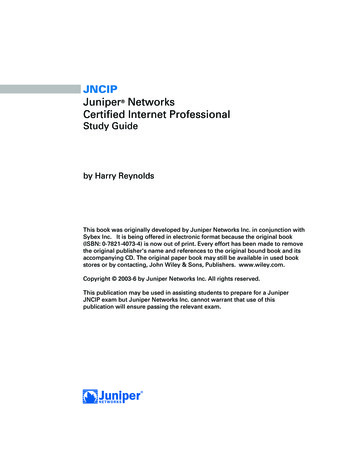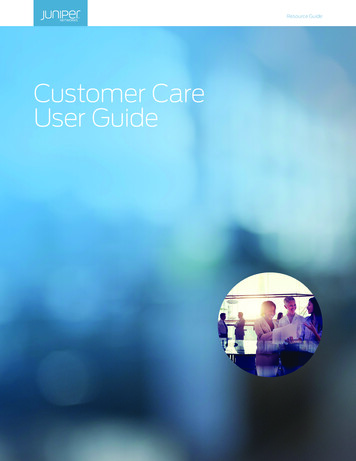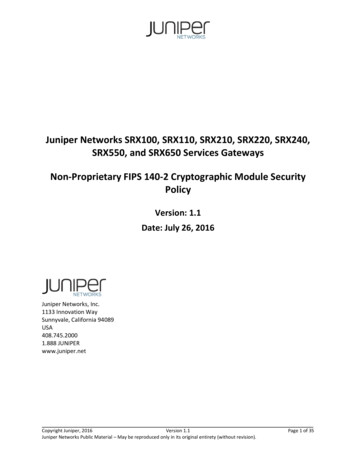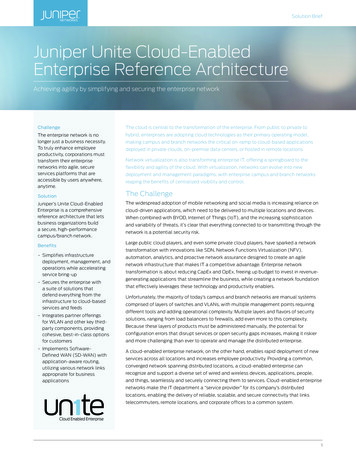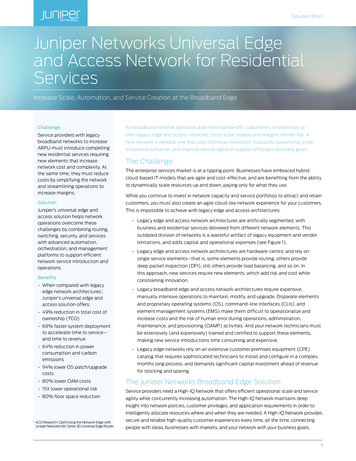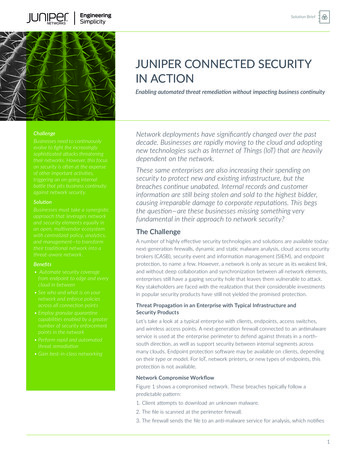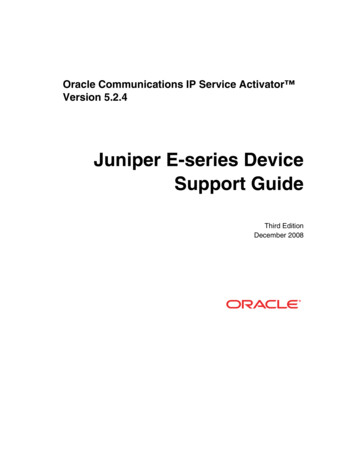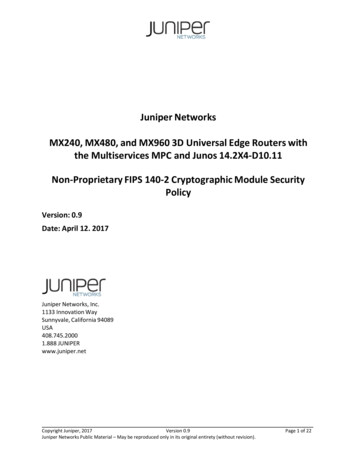
Transcription
Juniper Networks Third AnnualMobile Threats ReportMarch 2012 through March 2013
Table of Contents03 Executive Summary05 About Juniper’s Mobile Threat Center and Mobile Malware Database06 The Growth of Mobile MalwareMalware Production Trends. . . . . . . . . . . . . . . . . . . . . . . . . . . . . . . . . . . . . . . . . . . . . . . . . . . . . . . . . . . . . . . . . . . . 07Types of Malware. . . . . . . . . . . . . . . . . . . . . . . . . . . . . . . . . . . . . . . . . . . . . . . . . . . . . . . . . . . . . . . . . . . . . . . . . . . . . . . 08A Note About Apple iOS . . . . . . . . . . . . . . . . . . . . . . . . . . . . . . . . . . . . . . . . . . . . . . . . . . . . . . . . . . . . . . . . . . . . . . . . 0909 Malware Follows Markets: Android’s Appeal For Malware AuthorsUnique Mobile Malware Samples: Android Versus the Others. . . . . . . . . . . . . . . . . . . . . . . . . . . . . . . . . . . 09The Drivers of Android Malware. . . . . . . . . . . . . . . . . . . . . . . . . . . . . . . . . . . . . . . . . . . . . . . . . . . . . . . . . . . . . . . . . 10An Emerging Android Monoculture . . . . . . . . . . . . . . . . . . . . . . . . . . . . . . . . . . . . . . . . . . . . . . . . . . . . . . . . . . 10Anonymity of App Developers . . . . . . . . . . . . . . . . . . . . . . . . . . . . . . . . . . . . . . . . . . . . . . . . . . . . . . . . . . . . . . 11Loosely Managed Open App Marketplaces Abet Malware Authors. . . . . . . . . . . . . . . . . . . . . . . . . . . 11Malicious Mobile Marketplaces: A Geographic Breakdown. . . . . . . . . . . . . . . . . . . . . . . . . . . . . . . . . . . 12Loose Management of Android Devices . . . . . . . . . . . . . . . . . . . . . . . . . . . . . . . . . . . . . . . . . . . . . . . . . . . . . 1314 The Barrier to Entry for Attacks Gets Even Lower15 Enterprise Under AttackThe Anatomy of an Enterprise Attack: NotCompatible. . . . . . . . . . . . . . . . . . . . . . . . . . . . . . . . . . . . . . . . . . 15Mobile Botnets and Tascudap . . . . . . . . . . . . . . . . . . . . . . . . . . . . . . . . . . . . . . . . . . . . . . . . . . . . . . . . . . . . . . . . . . 18Device Theft and Loss. . . . . . . . . . . . . . . . . . . . . . . . . . . . . . . . . . . . . . . . . . . . . . . . . . . . . . . . . . . . . . . . . . . . . . . . . . 19Data Privacy Still Elusive on Mobile Devices. . . . . . . . . . . . . . . . . . . . . . . . . . . . . . . . . . . . . . . . . . . . . . . . . . . . . 19Privacy Violations: An Upward Trend. . . . . . . . . . . . . . . . . . . . . . . . . . . . . . . . . . . . . . . . . . . . . . . . . . . . . . . . . . . . 20Data Privacy: An Issue for Enterprises. . . . . . . . . . . . . . . . . . . . . . . . . . . . . . . . . . . . . . . . . . . . . . . . . . . . . . . . . . . 21Tablets Spur Enterprise Mobile Device Adoption And Possible Attacks . . . . . . . . . . . . . . . . . . . . . . . . 2122 How We Did: Revisiting Our 2011 Predictions23 A Look Ahead: The Evolving Threat Landscape24 Guidance for Enterprises25 About Juniper Mobile Security and Junos Pulse26 ReferencesThird Annual Mobile Threats Report Copyright 2013, Juniper Networks, Inc.2
Juniper networks Mobile Threat CenterThird Annual Mobile Threats Report:March 2012 through March 2013Faster, better, cheaper: mobile malware creators take lessons frombusiness to improve profitability through faster go-to-market strategiesOver the past year, the Juniper Networks Mobile Threat Center (MTC) found rapid mobilemalware growth and increased sophistication of cyber criminals, turning attacks into anincreasingly profit-driven business.Mobile devices and apps are becoming ubiquitous to both personal and professional lives, allowing for near anytime accessto critical information. It’s no wonder that adoption of smartphones and tablets, which offer Internet connectivity anddensely populated application ecosystems for add-on features, is growing at a torrid pace. According to Gartner, “Of the1.875 billion mobile phones to be sold in 2013, 1 billion units will be smartphones, compared with 675 million units in 2012.”1IDC expects tablet shipments alone to outpace the entire PC market by 2015.2The increasing reliance of smart devices has proven to be an irresistible target for attackers as they are quickly eclipsingcomputers in the post-PC era. From March 2012 through March 2013, the total amount of malware the MTC sampled acrossall mobile platforms grew 614 percent to 276,259 total malicious apps, compared with a 155 percent increase reportedin 2011. This trend suggests that more attackers are shifting part of their efforts to mobile.Developments in the threat landscape also point to malware professionals increasingly behaving like calculated businessprofessionals when devising attacks. Juniper Networks observed that similar to legitimate developers focused on the riseof mobile, cyber criminals are looking to maximize their return on investment (ROI) with their attacks. Through targetingthreats at Google Android with its commanding global market share, leveraging loosely regulated third-party marketplacesto distribute their illicit wares and developing threats that yield profits, it’s clear that the mobile malware writers are moresophisticated and chasing higher rewards for their efforts.Findings from the MTC in its third annual Mobile Threats Report, compiled by Juniper security researchers, show severalindicators of a shift in mobile malware from cottage industry to developed market: Targeting Markets with Greatest ROI: According to analyst firm Canalys, Android devices accounted for 67.7percent of all smartphones shipped in 2012 and is projected to ship over 1 billion smartphones in 2017.3 Just ascommercial sales teams have learned to “fish where the fish are,” cyber criminals are focusing the vast majority ofthreats on Android and its open ecosystem for apps and developers. By March 2013, Android was the target of 92percent of all detected mobile malware threats by the MTC. This is a significant uptick from 2011 when Android madeup 47 percent of all detected threats and 2010 where just 24 percent targeted the platform. Shortened Supply Chains and Distribution: Attackers made strides to shorten the supply chain and find moreagile methods to distribute their wares around the world. The MTC identified more than 500 third-party applicationstores hosting mobile malware. These third-party alternatives to official marketplaces often have low levels ofaccountability, allowing for malicious commodities to have a near infinite shelf life. These stores are also a concernfor the several million “jailbroken” iOS devices that rely on them to “side load” apps. Of these third-party stores, MTCresearch shows that three out of five originate from two emerging markets infamous for malware in the PC space:China and Russia.Third Annual Mobile Threats Report Copyright 2013, Juniper Networks, Inc.3
Multiple Paths to Market: Less sophisticated mobile criminals are exploiting holes in mobile payments to makea quick and easy profit by proliferating SMS Trojan and Fake Installer malware. These types of attacks make up 73percent of all malware sampled by the MTC. According to MTC researchers each successful download providesattackers around 10 USD in immediate profit.4 At the high-end of the market, more sophisticated attackers are usingbotnets and threats targeting high-value data on corporate networks in the enterprise. Operating System Fragmentation Causes Issues: Attackers continue to benefit from the largely fragmentedAndroid ecosystem that keeps the vast majority of devices from receiving new security measures provided by Google,leaving users exposed to even well-known and documented threats. Google provides protection against SMSthreats – which make up 77 percent of Android malware – in its latest OS version, yet according to Google, only fourpercent of Android phones have it as of June 3, 2013.5 This threat could be largely eliminated if the Android ecosystemof OEMs and carriers found a way to regularly update devices.The MTC examined more than 1.85 million mobile applications and vulnerabilities across major mobile operating systemplatforms to inform this report. Key findings and guidance, along with predictions about the evolving threat landscape,follow in this report.The Business of Mobile Malware:From Cottage Industry to Developed MarketA snapshot from the third annual Mobile Threats Report from Juniper NetworksMobile malware grew155%614%in 2011from March 2012 to March 201373% of all malware exploitholes in mobile payments bysending fraudulent premiumSMS messages, eachgenerating around 10 USDin immediate profit.a significant threat given more thanAndroid is responsible for92% of all known mobilemalware. An increase from47% in 2012.1 BILLIONAndroid-based smart phones are estimatedto be shipped in 2017Source: Canalys Smart Phone Report, June 2013There are more than500third-party app storescontaining malicious appsThird Annual Mobile Threats Report Copyright 2013, Juniper Networks, Inc.77% of Android threatscould be largely eliminatedtoday if all Android deviceshad the latest OS.Currently only 4% do4
About the Juniper Networks Mobile ThreatCenter and Mobile Malware DatabaseJuniper Networks Mobile Threat Center (MTC) research facility conducts around-the-clock security, vulnerability andmalware research on mobile device platforms and technologies. Working with partners throughout the security industry, theMTC analyzes attacks that leverage mobile devices as well as new threat vectors for mobile cybercrime and the potentialfor exploitation and misuse of mobile devices and data. This year, the MTC examined 1.85 million mobile applicationsacross major mobile online app stores, a 133 percent increase from the 793,631 applications we analyzed in our 2011 MobileThreats Report.There are many different ways companies in the industry analyze mobile malware, each with its own methodology. Thisreport seeks to measure each application or “instance” that can be considered malicious versus only looking at the majorfamilies of mobile malware. Further, unlike many other industry reports that measure when malware is found by researchers,the MTC measures when new malware is created, which provides a more accurate reflection of the growth of mobilemalware threats and eliminates much of the sample bias when a large cache of bad apps are found by researchers.The MTC gathers its malware using a variety of methods and sources including but not limited to: Mobile operating system application stores Third-party application stores around the world Known website repositories of malicious applications Known hacker websites and repositories Application samples submitted by customers Application samples submitted by partners Applications identified “zero day” as malicious by Junos Pulse Mobile Security SuiteWe want to note one caveat when discussing infection rates, which appears in the enterprise section. In an environmentas complex and distributed as the global mobile device marketplace, any sampling of mobile device infection rates isdirectional. We believe our mobile device data is representative of broader trends. We also provide clear footnotes where wehave supplemented data from third parties to complement Juniper’s own data.It is also important to remember that while the population of malicious mobile software is growing rapidly, it still remainssmaller than threats to computers. There are a number of reasons for this. For one, computers have been a target for muchlonger allowing their threats to mature over decades versus years. Further, most mobile devices do not run anti-malwareprograms to protect against threats, which give less incentive for malware authors to create many, different versions oftheir software to slip by detection tools. However, the threats are just as complex as what we know exists in the PC space.In its truest form, mobile malware has the ability to obtain highly complex control over the devices and the data it transmitsand receives.Third Annual Mobile Threats Report Copyright 2013, Juniper Networks, Inc.5
The Growth of Mobile MalwareMobile malware continues to grow at an exponential pace and remains the most popular hackingtechnique for devices.Overall, the growth of mobile malware continues to accelerate as the number of mobile users significantly increases.This growth demonstrates a substantial level of maturity with what has become a steady flow of new threats entering themarket each quarter. In March of 2013, the Juniper MTC identified a 614 percent increase in malware across all platformsas compared to the same time period the previous year. Total mobile malware samples across all platforms increased from38,689 at the end of the first quarter 2012 to 276,259 at the end of the first quarter in 2013.Total Mobile Malware Samples Across All Operating Systems AT END OF Q1Q1 2012Q1 201338,689 samples276,259 samplesThird Annual Mobile Threats Report Copyright 2013, Juniper Networks, Inc.6
Malware Production TrendsData compiled by Juniper found a clear increase in malware between November and February. It appears mobile malwareprofessionals follow a clear product development lifecycle with a very identifiable “busy” season.One theory is that the drop in new malware creation is evidence of the productization of malware, with malware authorsaligning their efforts to cyclical market demand. Just as legitimate companies develop and launch products timed with therelease of new devices and the holiday buying season, it’s possible that malware writers are doing the same thing. In thecontext of mobile malware, new smartphones and tablets are certainly the hot gift for many households, creating a readypool of new targets eager to download applications. As new smart devices and smart device users come online, so doesnew mobile malware.MONTHLY MALWARE CREATION ALL JanFebMarAprMayJunThird Annual Mobile Threats Report Copyright 2013, Juniper Networks, Inc.JulAugSepOctNovDec7
Types of MalwareMTC researchers found that between March 2012 and March2013 just three types of malware account for almost allmalicious activity on mobile devices that were sampled.Fake Install applications, malicious programs which mimicthe behavior of legitimate apps but require users to payattackers via premium SMS, made up 29 percent of Androidmalicious mobile apps. This is the most popular type ofthreat in a larger category known as SMS Trojans, whichsurreptitiously send SMS (short message service) textmessages to premium text messaging services. The othercategory is spyware applications, which secretly capture andtransfer user data to attackers.Together, these three types of threats make up more than9 out of every 10 malicious mobile applications analyzedby the MTC.Attack Makeup as of March 2013 – Android4% Other8,65329% Fake Install19% Trojan Spy70,64846,025This does not mean that iOS is more secure than Android.In fact, 2012 saw the first confirmed instance of asuspicious mobile application being distributed fromboth Google Play and the Apple App Store. Kaspersky Labwrote in July about the Russian language app “Find andCall” which downloaded users’ address books and sendsSMS spam to them.6 Further, enterprises and consumersusing Apple devices are not afforded the choice ofsecurity solutions to protect their devices. Apple devicesecurity is handled exclusively by Apple, with no insight onmalicious application statistics and detection capabilitiesmade available to the public. This forces consumers andenterprises to put all of their mobile security “eggs” in onebasket, so to speak. Android, on the other hand, has seensignificant innovation in security products available to users– both free and paid.The factors contributing to the dearth of malware on iOSand the abundance of it on Android has more to do withthe latter’s large user population, its broad geographicdistribution, and the ease with which malware authors canget their code onto vulnerable mobile devices. As we noted,cybercriminal groups that are exploiting mobile malwaremay be prioritizing a short path to profitability (cash-out)and easy distribution. Apple’s “walled garden” approachmakes both of these objectives more difficult to achieve.Does that mean there is no malware problem in theiOS world? It’s hard to say. Apple says little about itsmanagement of the App Store or about malicious andsuspicious mobile apps it discovers there. Most of whatwe know comes by way of independent observers workingoutside of Apple. We know there have been instances ofapplications being pulled from the App Store for violatingApple’s terms of services. How common an occurrencethat is, or how many such applications get flagged eitherbefore or after publication on the App Store, is a matterof conjecture.48% SMS Trojan114,677A Note About Apple iOSAs we noted in last year’s report, malicious programs forApple’s iOS platform are noticeably absent from Juniper’smobile malware database. This isn’t a phenomenonunique to Juniper. Theoretical exploits for iOS have beendemonstrated, as well as methods for sneaking maliciousapplications onto the iOS App Store. But cyber criminalshave by and large avoided Apple’s products in favor of thegreener pastures offered by Google Android.Third Annual Mobile Threats Report Copyright 2013, Juniper Networks, Inc.Finally, iOS users who circumvent Apple’s content protectiontechnology - or “jailbreak” their phones - are quitevulnerable to malicious infection, especially when loadingapplications from external application marketplaces thatcater to jailbroken iOS devices. According to the Cydiaapp store used for jailbroken divices, a tool named evasi0nhas been used to jailbreak nearly 18 million devices runningiOS.7 These devices also don’t have the benefit of themany anti-virus solutions available to Android users.8
Malware Follows Markets: Android’s Appealfor Malware AuthorsMobile malware professionals are maximizing their return on investment by targeting Androidbecause of its global market dominance and open platform. Like legitimate businesspeople,malware professionals look to exploit the largest addressable market opportunity.The complexion of mobile malware has changed drastically in the span of just a few years, following mobile phone adoptionand use patterns. As we noted in last year’s report, until 2010, most mobile malware targeted Nokia’s Symbian operatingsystem and Oracle’s Java Platform, Micro Edition (Java ME), a widely used mobile device environment that is supported bymobile phones and embedded devices such as TV set-top boxes and printers.Beginning in 2011, the mobile malware landscape changedwhen the MTC detected a shift in attacks from Symbianto Google’s Android mobile operating system. This trendaccelerated in 2012 and Q1 of 2013. By March of 2013, theMTC collected 253,304 samples of Android malware,making Android the target of 92 percent of detected threatsin the mobile malware arena.Android is the target of 92 percentof detected threats in the mobilemalware arena.Unique Mobile Malware Samples: Android Versus the OthersHow prevalent is Android malware? The graph below is a comparison of unique malware* samples detected in 2011 andMarch of 2013.DECEMBER 201153% Other PlatformsWindows Mobile JAVAMEBlackberry SymbianMarch 201347% Android8% Other PlatformsWindows Mobile JAVAMEBlackberry Symbian92% AndroidFor the purposes of this report, Juniper defines a mobile malware sample as a unique instance of a mobile application whose content or actions were deemedmalicious by the Juniper MTC.*Third Annual Mobile Threats Report Copyright 2013, Juniper Networks, Inc.9
The Drivers of Android MalwareThe preference of mobile malware authors for Google’s Android OS is rooted in a number of factors. It may surprise readersto learn that the security of the underlying Android OS isn’t one of those factors. Data included in security firm Symantec’s2012 Internet Security Threat Report (ISTR) showed Apple’s iOS was the source of almost all the mobile applicationvulnerabilities reported last year, 387 of 415, or just over 93 percent.8 The rest of this section explores the major factorscontributing to the attacker focus on Android.An Emerging Android MonocultureThe first and most important of these factors is Android’s commanding share of the global smartphone market. Accordingto analyst firm Canalys, 67.7 percent of all smartphone shipments worldwide in 2012 were Android devices compared to 19.5percent for Apple and 4.8 percent for Blackberry.3WORLDWIDE smart phone ACKBERRY5.6%OTHERSsource: Canalys 3In other words, Android is emerging as a dominant player in what has traditionally been a fragmented mobile OSmarketplace. And, as we saw with Microsoft’s Windows operating system, OS monocultures attract the attention ofmalicious actors who would rather fish in a pond with more, rather than fewer fish.Third Annual Mobile Threats Report Copyright 2013, Juniper Networks, Inc.10
Anonymity of App DevelopersOn the question of Google Play and the Android application ecosystem, 2012 found Google giving would-be app publishersmore scrutiny. But the company still sets a low bar for entry to Google Play. Would-be mobile application developers onlyneed to have a valid Google account, agree to the Google Play Developer distribution agreement and pay a 25 DeveloperRegistration Fee with a credit card to begin publishing.9 In contrast, Apple requires developers to have an Apple ID, pay anannual fee of 99 to join the iOS Developer Program and provide basic personal information, including their legal nameand address. Companies that want to publish on the App Store must submit additional information proving their legalstatus before being allowed to publish their creation to the App Store.10 Finally, Apple scans submitted applications prior topublication on the App Store, rather than scanning already published applications, as Google does with Bouncer.Loosely Managed Open App Marketplaces Abet Malware AuthorsMost significantly, Google’s support for mobile application stores abets the work of mobile malware authors and hasbecome a major security sticking point. These third-party marketplaces have become a favored distribution channel formalware writers and offer a much shorter supply chain for getting their illicit wares to the public.One clear problem affecting Android marketplaces is a lack of accountability. In the interest of building up their inventory,third-party app markets may have few – if any – barriers to entry for mobile application developers. That results in poorquality and malicious applications making it onto these online stores and, from there, onto Android devices.Google closely manages Google Play, scanning new and legacy applications for potentially malicious activity with itsBouncer technology. But Google Play isn’t immune to such threats. In fact, malicious applications infect unwitting users.In December 2011, for example, the mobile security firm Lookout Mobile discovered 27 variants of RuFraud, an SMS Trojanbeing distributed from Google Play and targeting users in Europe and Russia.11In addition, a study conducted by researchers at North Carolina State University in December 2012 found that the malwaredetection rate for Bouncer ranged between 15 and 20 percent – hardly a comforting number.12 Still, when malware isdiscovered by Bouncer or otherwise reported to Google, the company moves quickly to take it down and prevent furtherinfection from its Google Play store.The same cannot be said for third-party Android markets. As we noted in our 2011 Mobile Threats Report, third-partyapplication stores are the leading source of the most common type of Android malware, Fake Installers, which pose aslegitimate applications in these online markets.Third Annual Mobile Threats Report Copyright 2013, Juniper Networks, Inc.11
Malicious Mobile Marketplaces: A Geographic BreakdownThe threat to users posed by third-party marketplaces is a global epidemic. In some countries, third-party stores arethe primary place where people find and download applications, making users in such countries much more susceptibleto attack.The following is an overview of the relative number of third-party application stores known by the MTC to be hostingmalware. These app stores present threats for Android, JavaME, Symbian, Windows Mobile and jailbroken iOS 27665554333ChinaRussiaUnited n UnionVirgin IslandsSwitzerlandFranceTaiwanUnited KingdomAustraliaCanadaSouth Korea311252122111111111IrelandVietnamBrazilCzech RepublicSpainHong 125150175Russia and Eastern Europe: Mirroring traditional PC malware trends, Russia and Eastern Europe are hotbeds for maliciousmobile activity. Many organized criminal groups are known to operate in the region and are responsible for a large majorityof the cybercrime experienced across the world. Malware is an easy moneymaking venture for these groups and it makessense that these groups exploit the rise of mobility.China: The People’s Republic of China (PRC) has a rapidly expanding population of smartphones, with Android beingthe predominant operating system. For many of the reasons discussed in this report, that makes the PRC an attractivemarket for criminals. As in Russia and the former Soviet republics, the official Google Play marketplace doesn’t have astrong presence in China. That means most Android users rely on less regulated third-party marketplaces that are easier tocompromise.The United States and Western Europe: The United States shows up as a strong third marketplace of hosted maliciousmobile applications. We believe this reflects the its overall position as one of the largest smartphone marketplaces inthe world. Other markets with a disproportionately high number of third-party apps stores found to host malware arealso among the top users of smartphones: Germany at 16 and the Netherlands at 13. And, given the websites targeted atthe United States are in English, it can be reasonably assumed that major markets like Canada, the United Kingdom andAustralia are equally vulnerable to malware on these markets.Third Annual Mobile Threats Report Copyright 2013, Juniper Networks, Inc.12
Loose Management of Android DevicesAndroid’s dominance of the mobile device market is only partly responsible for its attraction to malicious software authorsand the cybercriminals who back them. A fragmented Android ecosystem also contributes to the growing populationof malware.Over the years, Google’s decentralized ecosystem has made it difficult for software updates – including security patches –to make their way to Android users. Each Android update from Google must be adapted and then tested by handset makersfor each of their (many) hardware variants. That update is distributed to carriers who, in turn, push it to their customers.The consequences for users are often delays in important security upgrades. The latest data from Google reveals only 4percent run Android 4.2 – the latest version of the OS dubbed “Jelly Bean” – more than six months after its release.This lack of regular updates means many new protections provided by Google reach users very late or not at all or never.For instance, the threat posed by premium SMS based malware, which make up 77 percent of Android malware, could belargely mitigated if Android phones were to receive this latest update. The update gives users an alert when they are aboutto send or receive a premium SMS message, which will likely prevent many from being duped by this malware.platform versionsThis section provides data about the relative number of devices running a given version of the Android platform.donutjelly �4.0.4ice cream sandwich1525.6%4.1xjelly bean1629%174%4.2xeclairfroyojelly bean 4.1xgingerbreadData collected during a 14-day period ending on May 1, 2013. Any version withless than 0.1% distribution are not shown.ice cream sandwichhoneycombsource: Google 4This is a marked contrast from Google’s main mobile competitor, Apple. Although that company doesn’t provide acomparable market share breakdown by iOS version, third-party estimates put the market share for iOS 6, the latest version,at close to 90 percent.13Third Annual Mobile Threats Report Copyright 2013, Juniper Networks, Inc.13
The Barrier to Entry for Attacks GetsEven LowerLess sophisticated mobile criminals are exploiting mobile payments to make a quick andeasy profit.As we described in our 2011 Mobile Threats Report, Fake Installers are the most common form of Android malwarecirculating on the internet. Fake Installers – sometimes referred to as “Toll Fraud” malware – are often bundled with piratedor legitimate-seeming mobile applications that are downloaded and installed by a phone’s owner. When combined withsimilar SMS Trojan applications, Fake Installers made up 73 percent of the MTC’s entire malware collection, a 17 percentincrease from 2011.The MTC determined that each successful attack can bring on average 10 USD in immediate profit. This figure is based onthe reverse engineering of a popular Fake Installer, including testing the premium SMS function in the malware.4We believe there are good reasons to explain their continued popularity.2011March 201356% Fake Installers/SMS Trojans73% Fake Installers/SMS Trojans44% All other malware27% All other malwareFirst, Fake Installer programs are attractive to both expert and novice criminals because they are easy to create anddistribute. Unlike other kinds of malicio
Juniper networks Mobile threat Center third annual Mobile threats report: MarCh 2012 through MarCh 2013 Faster, better, cheaper: mobile malware creators take lessons from business to improve profitability through faster go-to-market strategies Over the past year, the Juniper Networks Mobile Threat Center (MTC) found rapid mobile
